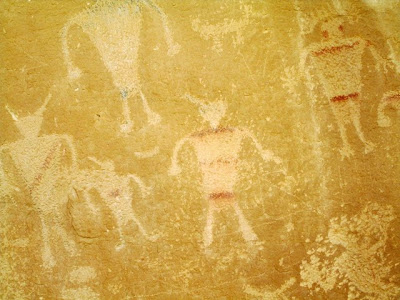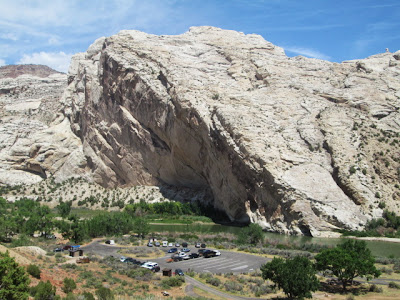
The brilliant colors in the land were rich and very appealing to an artist's eye. (If only I were an artist.)

According to the Park brochure there were petroglyphs on the face of this canyon wall but I couldn't see them. I am sure they were there--no self-respecting Indian artist would have passed up that spectacular canvas.

Archaeological evidence indicates that the Fremont people were in the Dinosaur area for about 600 years but their fate is unclear. Drought or the arrival of a new group of people may have caused the Fremont to leave or become assimilated. Whatever the case, it's difficult to trace the Fremont in the archaeological record after about 1200 AD.
The park is full of their petroglyphs and many were right alongside the road. (I have sworn off climbing around on cliffs for a while)

I may be wrong but doesn't that drawing above look anatomically correct?

This was like the Andy Warhol soup cans.

And this was a visiting Martian.

Wasn't there a cartoon horse named 'Sparky' or 'Sparkplug' that looked like this?

This building protects and highlights a quarry...

...that has been left exposed to show the visitors many of the bones as they lay.
This quarry yielded the remains of over 500 dinosaurs and other animals that lived during the Morrison time period.

Most of the fossils here are from huge dinosaurs. Large animals became trapped while smaller animals were swept away by the fast-flowing river.

There are no fossils here of lizards, fish, small dinosaurs or mammals.

And this particular mountain of bones will remain protected and intact.

Sauropods are the largest animals to ever walk on Earth. This was the most common group of dinosaurs in this region. Differences in their teeth show how the species specialized to eat different types of plants.

This fossilized skeleton of a young Camarasaurus (also known as a sauropod) is the most complete long-necked dinosaur ever found.

This dinosaur was the most common predatory animal in the Morrison ecosystem.

Allosaurus had sharp serrated teeth that lined its powerful jaws, large curved claws and powerful arm and leg muscles all of which allowed it to kill and eat smaller dinosaurs.

This dinosaur was the most common predatory animal in the Morrison ecosystem.

Allosaurus had sharp serrated teeth that lined its powerful jaws, large curved claws and powerful arm and leg muscles all of which allowed it to kill and eat smaller dinosaurs.

These trees were almost mystical in their ability to survive the harsh and punishing environment.

While standing and looking out over this landscape I met a couple from Maine, traveling for the first time in the west.

I asked them what they thought of the area and their answer was,
"We are overwhelmed by the vastness, the endless expanse when you can see for miles. We just did not expect it."

I agree. It is oh so very beautiful.
The next day I headed for Craig, Colorado.








No comments:
Post a Comment